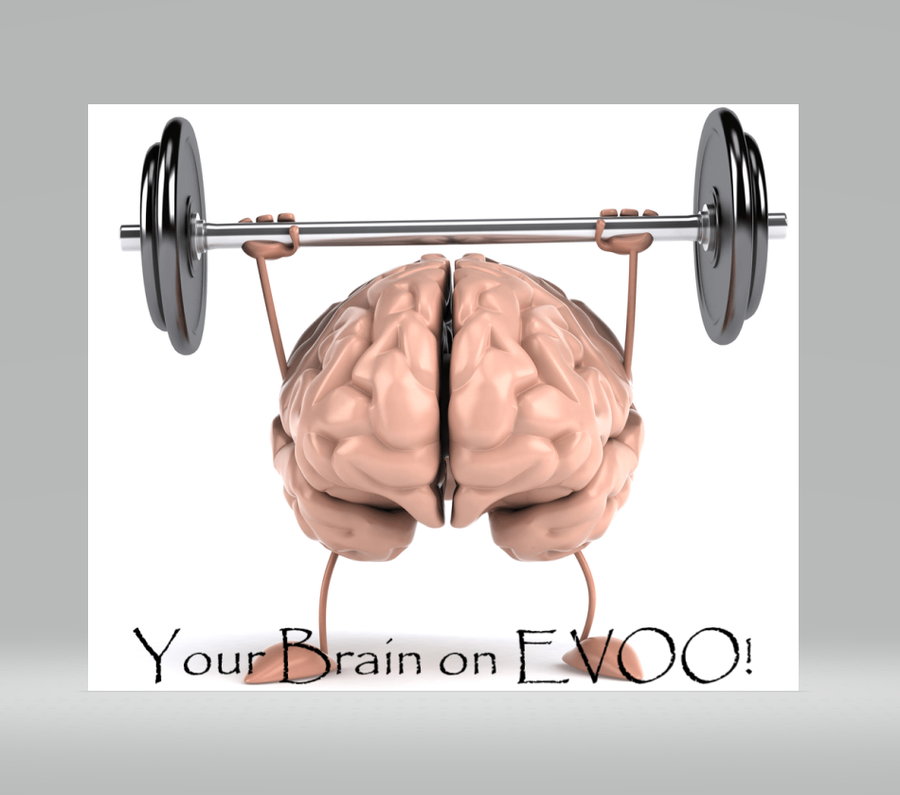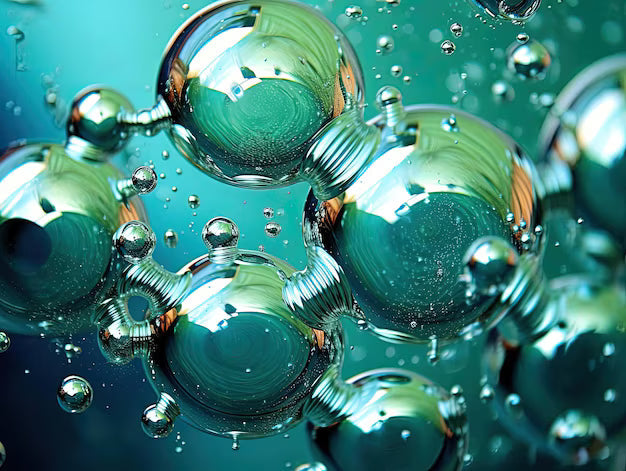Your Brain on EVOO, Part I - Blog #3

May 29, 2020
Happy Friday Everyone! Thank you for joining me today. I hope you have discovered some good information about consuming EVOO (Extra-Virgin Olive Oil) in the first two blogs that can benefit your health!
Q: “How old is EVOO before it goes rancid and how should it be stored?” (L. Seguin)
A: Great question! When it comes to EVOO, fresh trumps everything. If you keep your EVOO stored in a dark, cool pantry it is considered “fresh” for up to a year from the crush date. It will degrade faster if you submit it to sunlight and heat. It is not recommended to store fresh EVOO in the refrigerator. It lasts longest when kept at room temperature in a dark or opaque bottle.
I’m super excited about this week’s focus. The BRAIN and Nervous System
We can divide the “nervous system” into 2 parts.
1. CNS - central nervous system = brain and spinal cord
2. PNS - peripheral nervous system = all the nerves outside of the CNS that travel to every part of your body.
For the interest of time, I will focus on the brain as the major part of the CNS. Let’s get started!
“The human brain is more complex than any other known structure in the universe.” (Nationalgeographic.com: Human Brain: Information, Facts and News). It is the organ in charge of ALL body function. It is a tough 3# spongy mass of fat and protein! However, that’s not all. There’s a LOT of water. According to the Journal of Biological Chemistry, “the brain and heart are composed of 73% water, and the lungs are about 83% water. The skin contains about 64% water, muscles and kidneys are 79%, and even the bones are watery: 31%.” You think dehydration (not drinking enough water) can affect brain activity and mental clarity, among other things? The brain is the fattiest organ in the body, with a minimum of 60% fat (dry weight) and some hydrophilic (water-loving) proteins. You can think of the brain as the central command headquarters or central nervous system (CNS). This consists of the brain (and its many areas) and spinal cord. The nervous system outside the CNS is called the peripheral nervous system (PNS). You can think of the PNS as the team of relay runners that carry those signals back and forth between the brain and the rest of your body. So, you decide to move your arm. Your brain sends the message down the spinal cord to the connection with the PNS, where the signal is sent onward to the muscles responsible for moving your arm. Okay, so a very simplified version of what’s happening, but you get the picture. Now, it needs to do this very fast. Instantaneously! How? Now, this is clever. Your body wraps neurons in a sheath of MYELIN (consists of layers of fatty acids, proteins and water) that puts the information on a super-fast track to get it there quicker. In fact, the myelin sheath is 80% dry weight fatty acids, with Oleic Acid being in higher percentage to other fatty acids. Ok. So, what does this really mean? Let’s break this down. There’s a whole lot of fat in our heads! LOL…and other places. Our body cushions our nerves with fatty adipose tissue as well. Now, in order to achieve everything it needs to do, the brain requires a LOT of energy. There’s a lot of energy in fat. But, we want good fat because we want our brain to be healthy and repair itself. Now that we know that myelin is primarily made up of Oleic Acid, it only makes sense that it is so important to include EVOO in your diet!
Now that we’ve briefly covered the brain (CNS), let’s talk about the PNS (Peripheral Nervous System). Okay, visual. Let’s say the brain (CNS) is the powerhouse of the body. You can think of the PNS as the wires that go out to all the organs, bones, muscles and other tissues. There are two parts of the PNS, the autonomic nervous system (controls bodily functions without conscious control), and the sensory-somatic nervous system (transmits sensory information from the skin, muscles and sensory organs to the CNS and sends motor commands from the CNS to the muscles). Now, peripheral nerves can heal, but they heal slower than ANY OTHER TISSUE IN THE BODY. Studies demonstrated that the rate is slow at 1-2mm/day under optimal conditions. At the wrist for example (carpal tunnel) the distance required to heal is “approximately 100 mm over which axons must regenerate to reach many of the hand muscles.” So, at least 100 days. When peripheral nerves are deprived of oxygen (diabetes, decreased oxygen in the vicinity, sitting for long periods of time and other reasons), over time a condition called “neuropathy” can develop. This is a very uncomfortable condition that can lead to complete loss of sensation. This is one reason physical exercise is so important! Get up and go for a walk. Move. Your muscles will demand more oxygen, which increases the surrounding blood flow giving your peripheral nerves the oxygen they need to stay healthy.
Okay, so now that we understand the brain and nervous system a little better, let’s dig deeper. After all, the brain is in charge! Information processing speed of the human brain can reach 120 meters/sec. In fact, the brain is SO important it has priority to blood. With each heartbeat, your brain receives approximately 20-25% of your blood, where it gobbles up roughly 20% of the oxygen and fuel. If you are thinking REAL HARD it can use up to 50%!!! (Alzheimer’s Disease and the Brain) Yes, very needy indeed. Whew! Good thing I’m sitting down. Wait! How in the world can it do this? If the blood vessels in the brain were stretched out end-to-end, it “would be about 100,000 miles long.” Let’s consider this a minute… Let’s go way back to brain development, which begins very early in the developing fetus. The brain grows at a rate of a quarter million neurons per minute in the first trimester. The newborn’s brain triples in size during the first year. WOW! Now we can see just how important blood flow and oxygen is to the brain.
Oh, and one more thing. The brain has a special protective filter called the BBB (blood brain barrier). The BBB “maintains cerebral micro-environmental homeostasis.” Now, this just means it is there to NOT ALLOW anything in (virus, bacteria, toxin, etc.) that can harm the brain and central nervous system and keep things in balance. Studies show that the BBB is readily crossed by unsaturated fatty acids (UFA), while saturated fatty acid (SFA) transport is via proteins. This indicates to me how important the brain thinks UFAs are, while limiting SFAs. In fact, on autopsy Alzheimer’s Disease, Parkinson’s Disease and many other neurological diseases demonstrated low levels of oleic acid and omega 3s. If you’ve never seen the movie “ Lorenzo’s Oil,” check it out. It is based on a true story of parents relentlessly in search of a cure for their son. Susan Sarandon and Nick Nolte star. Their discovery led to lots of research on the supplementation of dietary fatty acids and prevention of disease. Recent studies show that oleic acid can prevent and even reverse some of the damage from Alzheimer’s and Parkinson’s that occurs in the brain. How does it do this? It prevents damaging plaques from forming and helps to remove them as well. Multiple studies are showing significant benefits from consuming high polyphenol EVOO with regards to protecting against and treating several neurological conditions. These include Alzheimer’s Disease, Dementia with Lewy bodies, Parkinson’s Disease, Multiple Sclerosis, ALS, CVA (stroke) and more.
Now we know the brain is made up mostly of fat. So repair must include fat, right? What kind of fat will help the brain stay healthy and repair itself? The nervous system has a very high concentration of fatty acids. The only thing that contains more is well, fat (white adipose tissue). Now, these fatty acids are active participants in brain development throughout the lifespan. Many recent studies have shown that when there is a sufficient quantity of MUFAs (monounsaturated fatty acids) ingested, it prevented the age-related deletion of mitochondrial DNA in the brain of aged animals. (Ochoa et al., 2011) Adding EVOO to the diet of animals in the study improved their memory in elders and improved spatial memory and learning ability of pups, promoted insulin sensitivity and cortical activity. Animals fed a diet with SFAs (saturated fatty acids) did not. MUFAs, mainly oleic acid, inhibits production of peptides and plaques that lead to Alzheimer’s.
Another study looked at 182 men and women aged 70 and suggested that long-term consumption of Mediterranean diet increases longevity through maintenance of the telomeres length and prevention of brain atrophy (shrinking). Telomeres are the caps at the end of each strand of DNA that protect our chromosomes (like the plastic on the end of shoelaces). Without the coating, they become frayed until they can no longer function. This sounds super important to me! A recent study on Telomeres, lifestyle, cancer, and aging (NIH, M. Shammas) shows “growing evidence that lifestyle factors may affect the health and lifespan of an individual by affecting telomere length.” Telomere length shortens with age and the rate can be increased or decreased by lifestyle factors. Biochemical Journal reported that oleic acid “strongly inhibited” the enzyme that eats away at the tips of your telomeres. I want long telomeres!
Whew. I’ve only covered a tiny portion of what is going on in the brain and nervous system. There’s so much more to talk about. However, the takeaway is the brain needs oleic acid. It also needs Omega 3s. Do something WONDERFUL for your brain. Eat fatty fish and drink your EVOO!
Next week’s focus is more a more detailed look at how Oleic Acid can impact Parkinson’s Disease, Dementia with Lewy bodies, Multiple Sclerosis and other neurological diseases prevalent in our society. Until then, exercise your brain & body, drink lots of water, and drink your EVOO!!
This blog is intended for informational purposes only. Discuss strategies with your Healthcare Practitioner.






